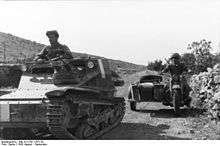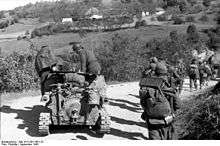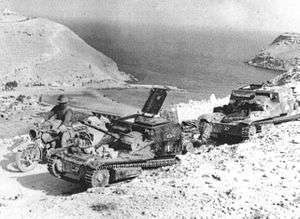L3/35
| Carro Armato L3/35 | |
|---|---|
|
L3/35 displayed at the South African National Museum of Military History (without machine guns). | |
| Type | Tankette |
| Place of origin | Italy |
| Service history | |
| In service | 1 October 1935 – circa 1944 |
| Used by |
Kingdom of Italy, Austria, Brazil, Kingdom of Bulgaria, Republic of China, Independent State of Croatia, Kingdom of Hungary, Nationalist Spain, and others |
| Wars | Austrian Civil War, Second Sino-Japanese War, Second Italo-Abyssinian War, Spanish Civil War, Greco-Italian War, Slovak–Hungarian War, Invasion of Albania, Anglo-Iraqi War, World War II |
| Production history | |
| Produced | 1935–1938 |
| Number built | 2,000 – 2,500 |
| Variants | L3/33, L3/38, L3 cc, L3 Lf, |
| Specifications | |
| Weight | 3.2 tonnes (3.5 tons) |
| Length | 3.17 m (10 ft 5 in) |
| Width | 1.4 m (4 ft 8 in) |
| Height | 1.3 m (4 ft 3 in) |
| Crew | 2 (commander and driver) |
|
| |
| Armour | 6–14 mm |
Main armament | 2 × 8 mm machine guns or 1 FIAT-OCI flame-thrower |
| Engine |
FIAT-SPA CV3 water cooled 43 hp (32 kW) |
| Suspension | bogie |
Operational range | 125 km (78 mi) |
| Speed | 42 km/h (26 mph) on road |
The L3/35 or Carro Veloce CV-35 was an Italian tankette that saw combat before and during World War II. Although designated a light tank by the Italian Army, its turretless configuration, weight and firepower make it closer to contemporary tankettes. It was the most numerous Italian armoured fighting vehicle and saw service almost everywhere the Italians fought in World War II but proved inadequate for modern warfare having too thin armour and weak armament of only machine guns.
Development
The L3/35 was developed from the Carden Loyd Mark VI tankette, four of which were imported from Britain in 1929. The first vehicle developed by the Italians from the Carden Lloyd tankette was designated CV-29; "CV" being an abbreviation of Carro Veloce (Italian: "fast tank") and "29" as the year of adoption. Only twenty-one CV-29s were built.
L3/33
In 1933, a new design was built jointly by the Fiat Company of Turin and the Ansaldo Company of Genoa. This vehicle was introduced as the Fiat-Ansaldo CV-33. About 300 CV-33s were built.
L3/35
In 1935, a slightly improved model of the CV-33 was introduced and designated CV-35. The primary differences were that the armour was bolted rather than riveted and the single 6.5 mm machine gun was replaced with twin 8 mm machine guns. Many older CV-33s were retrofitted to meet the specifications of the CV-35. In 1938, the vehicles were redesignated L3/33 ("L" for Leggero or 'light') and the L3/35.

L3/38
In 1938, a further development of the L3 design was designated L3/38. The L3/38 had torsion bar suspension and two versions of a single mounted 13.2 mm machine gun. In 1937 Brazil bought 24 L3/38s which arrived in 1938. The L3/38s exported to Brazil were designated "CV33/II". The Roman numeral "II" represents the second version of the original L3/33 version. The L3/35 version exported to Brazil would be "CV33/I" (the CV33 or L3/33 and the CV33/I or L3/35 export versions to Brazil had no torsion bar suspension). The CV33/II Brazilian export was armed with a single 13.2 mm Madsen machine gun.
Italy retrofitted at least 12 L3/35s to meet the specifications of the L3/38. The converted L3/35s with the L3/38's torsion bar suspension saw limited service in September 1943 until June 1944. These L3/38s versions of the L3/35s were armed with a single 13.2 mm Breda M31 machine gun.
Layout
The L3/35 was a lightly armoured two-man vehicle typically armed with twin 8 mm machine guns, though variants were developed with other armament. Other than the number and type of machine guns, the differences between the L3/35 and the L3/33 were few. Both featured riveted and welded construction.
The vehicle's commander/gunner sat on the left and the driver sat on the right. The engine was mounted transversely [1] in the rear. A circular radiator was mounted behind the engine. The transmission went to the front to the final drive. The Vickers-Carden-Lloyd type suspension had two three-wheel bogies on leaf spring and a single unsprung wheel on each side. There was an acacia wood rail that the top run of the tracks went on.
Production and sales
Between 2,000 and 2,500 L3 tankettes were built in different models and variants for the Royal Italian Army (Regio Esercito) and for other users. Twenty L3/33 tankettes were sold to China. Other L3 tankettes were sold to Afghanistan (unknown number), Albania (unknown number), Austria (72), Bolivia (14), Brazil (23), Bulgaria (14), Croatia (10), Hungary (65), Iraq (16), Nationalist Spain, and Venezuela (2). Many foreign buyers substituted other machine guns as the main armament. The Hungarians added a raised commander's vision cupola on some of the L3s they acquired. In 1938, the Brazilian Army bought several L3/35 tankettes which remained in active service until 1945 when some units were resold to the Dominican Republic. Venezuela bought two units in 1934 for evaluation in infantry support operations, because of several incidents on the border with Colombia, like other weapons acquired from the Italian mission they did not survive past World War II.
Combat history



In addition to seeing action in the Second Italo-Abyssinian War, the Second Sino-Japanese War, the Spanish Civil War, the Slovak-Hungarian War, and the Anglo-Iraqi War, the L3 was used almost everywhere that Italian troops fought during World War II. L3s were found on the Italian/French border, North Africa, Italian East Africa, the Balkans, USSR, Sicily, and Italy.
The combat performance of the L3s during the interwar period was poor. On at least two occasions during the Italian invasion of Ethiopia, L3s were put out of action by massed infantry attacks. In the Spanish Civil War, L3s of the Corps of Volunteer Troops (Corpo Truppe Volontarie, or CTV) were totally out-classed by the T-26 and BT-5 tanks provided to the Republican forces by the Soviet Union. Fortunately for the Hungarians, the L3s were not a factor in their brief war with Slovakia.
On 10 June 1940, when Italy entered World War II, the Royal Italian Army (Regio Esercito) possessed only about one-hundred M11/39 medium tanks in two tank battalions. L3 tankettes still equipped all three Italian armoured divisions, the tank battalions in the motorized divisions, the light tank squadron group in each "Fast" (Celere) division, and numerous independent tank battalions.
On 22 March 1941, two Iraqi L3s were reported to have been put out of action near Fallujah during the Anglo-Iraqi War.
More than 40 captured L3 tankettes were used by the Greek Army during the Greco-Italian War, fought from 1940 to 1941, and were used to equip the 19th Mechanized Division, although they did not take part in combat with the latter. After the invasion of Yugoslavia and Greece in April 1941, L3 tankettes were also captured by the Yugoslav and Greek resistance forces. From 1941, some L3 tankettes were given to the German puppet government of the Independent State of Croatia (Nezavisna Država Hrvatska, or NDH).
Though numerous, Italy's tankettes proved to be outclassed from the start and also proved to be of low tactical value. They were vulnerable to the British Boys anti-tank rifles.[2] Other than those used for occupation duties in the Balkans and elsewhere, few L3s remained in front line service past the end of 1940. After the Italian armistice with the Allies in 1943, L3 tankettes were used by German Army forces and by the pro-Nazi National Republican Army of the Italian Social Republic. Hungarian L3s had by this point been issued to the Gendarmerie and 10 saw combat in Budapest and were destroyed in the fighting to reclaim the Racecourse Airfield.[3]
L3/35s also joined the Chinese Nationalist Army and fought against the Japanese Imperial Army during the Second Sino-Japanese War.
Variants


The L3/35 appeared in several variants including an anti-tank variant and a flame thrower variant.
L3 cc anti-tank
The "L3 cc" anti-tank (controcarro) was an L3 with a Solothurn 20 mm anti-tank rifle mounted in place of its normal machine gun armament. Only a few were so modified, and they saw action only in North Africa.
The Solothurn rifle could penetrate up to 18 mm of armor at 300 m (328 yards) which was effective against lightly armoured vehicles.[4]
L3 Lf flame tank
Development of the "L3 Lf" flamethower (lancia fiamme) flame tank began in 1935. The flamethrower nozzle replaced one of the machine guns, and the flame fuel was carried in an armoured 500 liter (133 gallons) fuel trailer towed by the vehicle. Later versions carried another 60 liters of fuel in a box-shaped tank mounted above the L3's engine compartment. The vehicle weighed 5 metric tons.
The L3 Lf saw action in Abyssinia, Spain, France, the Balkans, North Africa, and Italian East Africa. From 1936 each CV/L3 company had a single L3 Lf platoon.[5]
L3 Centro Radio command tank
The basic L3 platform was also employed as a command vehicle using the Marelli RF1 CA radio in platoon and company command vehicles. The L3 was considered too small to be effectively employed as a regimental level command radio vehicle so this task fell to the later and slightly larger L6/40 CR (Centro Radio = Radio Center).[5]
L3 Passerella bridge layer
The few L3 Passerella (bridge layer) vehicles constructed were assigned to units at Armoured Brigade levels. The 7 meter (23 feet) long bridge was stripped down into sections on a trailer towed by the L3 itself for travel. On arriving at the combat zone, this bridge was assembled on the front of the tank, suspended by cables from two small cranes located over the crew's superstructure. The crew laid the completed bridge over the obstacle from within the vehicle. A L3 Passerella crew took seven minutes to lay out this bridge.[6]
Planned variants
A single Savoia-Marchetti SM.82 aircraft was modified to carry a L3/33 recessed under the fuselage for experiments with airborne armour.[7]
Carro Veloce Recupero
Unarmed armoured recovery vehicle with a rear tow bar, did not progress beyond the prototype stage.[7]
Semovente L3 da 47/32
Tank destroyer with a 47 mm L/32 gun mounted in the hull, based on the L3/35. At least one built but did not enter service.[7]
L3 tank
Tank built by Fiat-Ansaldo in 1937 on the L3/33 chassis with a redesigned hull and a 20 mm gun in a rotating turret. Did not enter serial production.[7]
Aborted Spanish upgrade
On 8 August 1937, Major General García Pallasar had received a note from Generalísimo Francisco Franco which expressed the need for a Panzer I armed with a 20 mm gun. Although originally forty Italian L3/35 tankettes were ordered with the original armament exchanged for the 20 mm Breda Model 35 instead, this order was subsequently cancelled after it was thought that the adaptation of the same gun to the German Panzer I would yield better results.[8]
Users
_crowned.svg.png) Kingdom of Italy
Kingdom of Italy.svg.png) Afghanistan
Afghanistan Republic of China
Republic of China Spain
Spain.svg.png) Kingdom of Hungary
Kingdom of Hungary Kingdom of Bulgaria
Kingdom of Bulgaria First Austrian Republic
First Austrian Republic.svg.png) Nazi Germany
Nazi Germany.svg.png) Brazil
Brazil.svg.png) Greece
Greece.svg.png) Iraq
Iraq Venezuela (the 2 examples were the first armoured vehicles used by its army)
Venezuela (the 2 examples were the first armoured vehicles used by its army)
See also
- Military history of Italy during World War II
- List of tanks in the Spanish Civil War
- Tank and Armoured Cars Group
- Weapons employed in the Slovak-Hungarian War
References
- Notes
- ↑ Italy's L3/33 (CV 33) and L3/35 (CV 35) tankettes wwiivehicles.com
- ↑ Pignato 2004,p. 8
- ↑ Grey Wolf, Battlefront Miniatures,2011
- ↑ Pignato 2004,p. 18
- 1 2 Pignato 2004,p. 8-9
- ↑ Pignato 2004, p. 12.
- 1 2 3 4 Miller, Chris, The Illustrated Directory of Tanks of the World, Zenith Imprint (2000), ISBN 0760308926, pp.166-167
- ↑ Franco, Panzer I, pp. 47-49
- Bibliography
- Franco, Lucas Molina (2005). Panzer I: El inicio de una saga (in Spanish). Madrid, Spain: AF Editores. p. 64. ISBN 84-96016-52-8.
- Pignato, Nicola (2004). Italian Armored Vehicles of World War Two. Carrollton: Squadron/Signal Publications. ISBN 978-0-89747-475-7.
External links
| Wikimedia Commons has media related to L3/35. |
|
|
- L3/33 (CV 33), L3/35 (CV 35) Tankettes at wwiivehicles.com
- L3/35 at onwar.com
- A history of military equipment of Modern Greece (1821 - today): L3/35
